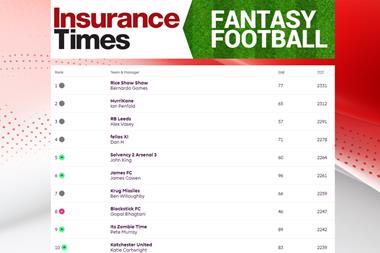In the third part of a quarterly series, Jim Keeling rounds up the latest deals in the insurance market and asks how long the drought of large mergers and acquisitions will last.
For deal-makers and advisers accustomed to working on big mergers and takeovers, the statistics for the third quarter of 2008 make grim reading. Like the insurance giant AIG, deal volumes have been buffeted by the credit crunch.
During the summer break there was silence in the City of London, home to so much of the UK’s insurance industry. The latest statistics show it was not only day-to-day activity that slowed down, but also the appetite for larger mergers and acquisitions.
As a result the armies of advisers – from accountants to lawyers and due diligence specialists to corporate financiers – together with bankers and equity funders were for once able to stop working late and take a break – only to find that the grey skies at work were matched by equally grey English skies at home.
This quarter we have split deals done into two categories. The charts, produced by Corpfin, show completed acquisitions where the buyer or seller carries on insurance-related activities in the UK and the price was publicly disclosed at either above or below £40m.
In the higher category there were no deals done this quarter and, while that may occasionally have happened before in a single month, especially August, it is highly unusual for a whole quarter to go by without even one larger deal. Admittedly the statistics are provisional and, at the time of writing, there are still a few days of the quarter to go. It is possible that details of deals may emerge after the end of the quarter. But even the most hardened optimist of a deal-maker must have cause for concern.
The £900m acquisition of Benfield by Aon would have provided a welcome boost but, as that has not completed yet, it misses the cut. Even on that deal nothing is certain for the principals and advisers involved. Given the regulators’ recent tactic of waving through deals (as in the Lloyds TSB takeover of HBOS), however, perhaps they are not biting their nails about regulatory conditions as much as they might in easier times.
The picture on smaller deals is radically different. The rationale for mergers and acquisitions – for example, broker consolidation, which is largely driven by a plethora of sub-£40m deals – remains. Improvements can still be extracted from combined businesses so the buyers are still there.
The charts show there has not been much more than an average slowdown for smaller deals in the third quarter. Overall, 2008 looks like being a better year in terms of numbers and perhaps also in terms of aggregate volumes than any in recent memory.
So what of the quarter coming up? The other transaction that would have a blockbuster effect on the larger deal statistics is the widely discussed disposal by Royal Bank of Scotland of its insurance activities. For advisers, at least, every cloud has a silver lining: out of adversity comes a need for transactions to start all over again. This time round, though, deals would be done for defensive reasons to shore up the seller’s banking ratios or just to provide much needed cash.
In the longer term, many private equity houses, which have been the source of funding for much of the deal activity in recent years, still have their coffers full. Although debt may be harder to come by, these equity funders still have to spend their cash in order to earn a living and are ready to use it to snap up businesses in difficulty. So our expectation is that, come rain or sun, deals will continue – albeit not always with the same rationale driving them.
Jim Keeling is joint chairman of Corbett Keeling – an adviser on funding buy-outs and selling businesses in the insurance sector.




































